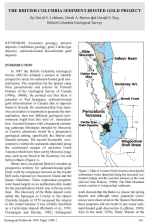Добрый день, Коллеги. Важное сообщение, просьба принять участие. Музей Ферсмана ищет помощь для реставрационных работ в помещении. Подробности по ссылке
The British Columbia sediment-hosted gold project / Проект по добыче золота в отложениях Британской Колумбии
In 1997 the British Columbia Geological Survey (BCGS) initiated a project to identify prospective areas for sediment-hosted gold mineralization. The inspiration for the project came from presentations and articles by Howard Poulsen of the Geological Survey of Canada (1996a, 1996b). He pointed out that there is potential to find hypogene, sediment-hosted gold mineralization in Canada akin to deposits found in Nevada. He mentioned that if an intrusive association is important to generate the mineralization, then two different geological environments might host this style of mineralization. Accreted terranes with a basement containing carbonate lithologies intruded by Mesozoic or Cenozic plutonism would be a prospective geological setting, specifically the Stikine and Quesnel terranes. The second favourable environment is within the sediments deposited along the continental margin of ancestral North America which have been cut by Mesozoic magmas, such as are found in the Kootenay Arc and Selwyn Basin (Figure 1).
Others have considered British Columbia as prospective territory for sediment-hosted gold. Early work by companies focused on the Insular Belt rocks exposed on Vancouver Island and the Queen Charlottes. These exploration programs were based largely on an epithermal-style model for the mineralization which was in favour at the time. The discovery of the Babe deposit (now called the Specogna or Cinola) in the Queen Charlotte Islands in 1970 increased the interest in this model because it was initially identified as a Carlin-type deposit (Richards et al, 1976; Champigny and Sinclair, 1982). <...>




